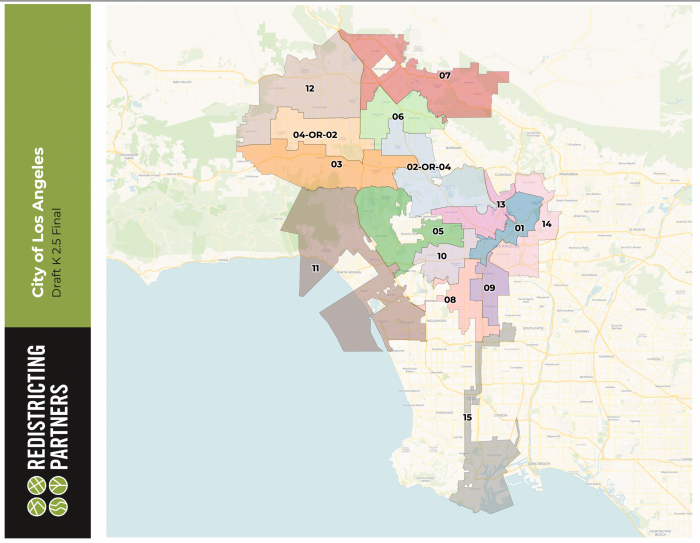
Two Los Angeles County supervisors pressed unsuccessfully today for a delay in implementing new boundaries for the five supervisorial districts, expected to be set Dec. 15 by the Citizens Redistricting Commission.
In response to a motion by Supervisor Hilda Solis to provide constituent services in accordance with the newly drawn districts within 24 hours of the CRC’s final decision, Supervisor Sheila Kuehl argued that a slower, more thoughtful transition would better serve county residents. “It just doesn’t make sense to me to change it that fast,” Kuehl said. “Fine, adopt the map, but let us do a more rational transition.”
She said some nonprofits rely on discretionary district funding that might not be honored by a new supervisor. Kuehl pointed to relationships that have taken years to build with neighborhood councils, nonprofits and other organizations that make up the fabric of her district. The Board of Supervisors has no authority over adoption of the CRC’s map. “(The legislature) did not want us meddling in it,” Solis said.
Once the CRC, which is holding a public hearing on the issue Tuesday evening, approves the final map, which is expected to happen Dec. 15, it will be sent to the county’s registrar-recorder. The board will have no vote or power to change the outcome. Supervisor Janice Hahn, who co-authored Solis’ motion, underscored that point.
“We cannot approve it, we cannot tweak it, we cannot reject it. This is out of our hands,” Hahn said. “But the least that we can do to respect this process is to adopt these district lines the next business day so that we can begin getting acquainted with our new district.” Both Solis and Hahn expressed concerns about the yet-to-be-determined boundaries themselves.
“I feel devastated from what I see in the maps that are being presented right now,” Solis said, pointing to seven once-under-represented cities in Southeast L.A. that she may lose in the process. Hahn said the process has been “messy” with “iterations of these maps every other day,” including one that “removed almost half my district.”
The boundaries have historically changed every 10 years in response to changing demographics reflected in census data. However, in years past, the county board itself drove the process, choosing the final map. County Counsel Rodrigo Castro-Silva said the earlier process offered a built-in transition time because of the board’s involvement.
“In the past … there was a lot more lead time … in terms of what the maps would look like, where the districts would fall and that would give … that transition period for the board offices to figure out the constituent services that they were going to provide and how they were going to do that,” Castro-Silva said.
He said the board does have discretion under the current process to decide how services will be provided in accordance with the new maps. The state law provides no guidance in this regard, according to Castro-Silva.
Supervisor Holly Mitchell tried to convince the motion’s authors to accept an amendment that would extend the effective date by 90 days — even as Kuehl said that wouldn’t resolve her concerns — but was rebuffed.
“We are a huge bureaucracy,” Mitchell said. “I’m not sure how you could think we could turn this in a single day. Let me speak as a former staffer: this will not be seamless, it can’t be.”
Even as the board has been closely monitoring the redistricting process, Mitchell said she believed most constituents would be caught off guard by the changes and some would have trouble getting the services they need. There is no database of constituent services to support the transition, she said, and the stakes are higher than usual in the midst of the pandemic.
Supervisor Kathryn Barger said she has been through four county redistricting moves.“Change is hard, but this is the reality,” Barger said, who presented an optimistic vision of how cooperation across the often-collegial board would smooth the transition.
Kuehl recalled that when she was in the state Legislature, constituent services were shifted to align with new district boundaries at election time, when voters were expecting changes and a new face. She made one last plea to her colleagues, raising concerns about honoring long-term commitments and constituent expectations.
“Is it the case then that I can no longer fund the Food for the Soul garden in Sylmar? I mean, I don’t give money outside my district,” Kuehl
asked. She cited the transfer of ownership of Bruce’s Beach as an example of an important commitment made by one supervisor that might shift jurisdiction.
Kuehl said if Manhattan Beach fell within her district, she would be just as fervent in supporting the work to return the shorefront property to the descendants of the Black family that once owned it, but noted that she wasn’t the one who had built relationships with the families and other parties involved in the complex transaction. Ultimately, the board voted 3-1-1 to pass the Solis-Hahn motion, with Kuehl dissenting and Mitchell abstaining.
Solis will be running for re-election in her newly drawn district next year, while Kuehl will step down at the end of her second term in December 2022. Several candidates are seeking to replace Kuehl despite uncertainty about which cities and unincorporated areas will be included in the district they hope to represent.






